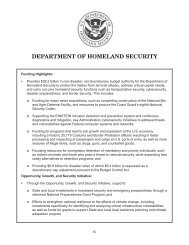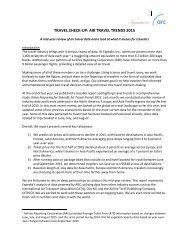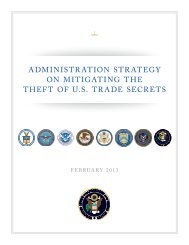A-HRC-13-42
Create successful ePaper yourself
Turn your PDF publications into a flip-book with our unique Google optimized e-Paper software.
A/<strong>HRC</strong>/<strong>13</strong>/<strong>42</strong><br />
page 30<br />
61. Latin American Governments justified practices of secret detention, among other<br />
exceptional measures, referring to the national security doctrine, which provided fertile ground<br />
for the creation of a repressive system by the military in which, in the name of security, human<br />
rights and fundamental freedoms were violated on a massive scale, and the rule of law and the<br />
democratic system damaged. The model was formulated in the 1940s, on the basis of French<br />
counter-insurgency concepts used in Algeria and Indochina. It was spread by the United States<br />
through the training of Latin American armies in “the school of the Americas”, located in<br />
Panama. Politically, the doctrine was strongly influenced by the bipolar cold war paradigm. It<br />
extended the notion of the alleged internal war against communism, which soon acquired a<br />
regional dimension. Practices of secret detention were first used against armed movements, later<br />
against left-wing groups, Marxist and non-Marxist, and ultimately against all groups suspected<br />
of political opposition. The latter were labelled as “subversives”, “terrorists” or “communists”.<br />
62. Practices of secret detention ran in parallel, at the national and regional levels. They were<br />
carried out by several governmental entities, which worked with little regulation and wide<br />
authority to interpret the few rules and regulations that did exist. Each entity had its own staff<br />
and facilities. Each organization worked in secrecy. 73 The prime example of the regional scope<br />
of these practices was operation Condor, involving the exchange of intelligence information, and<br />
relying upon inter-State programmes of renditions. 74 The operation was endorsed by the Chilean<br />
National Intelligence Directorate, which operated as the main intelligence service engaged in<br />
political repression between 1974 and 1977. Among its different functions, it was responsible for<br />
running secret detention centres, where victims were interrogated and tortured. 75 The Directorate<br />
soon began to work in Argentina, and later in other Latin American countries, the United States<br />
and Europe. 76 Similar intelligence services were established in Argentina, Paraguay and<br />
Uruguay, and integrated into a coordination network, closely linked to the United States. 77<br />
63. In Argentina, for instance, there were close to 500 secret detention centres, operating<br />
mainly on military or police premises. 78 Others were located in such diverse settings as hospitals,<br />
73 Memorandum of conversation, unclassified, 7 August 1979, Embassy of the United States of<br />
America, Buenos Aires.<br />
74 See International Commission of Jurists, “Assessing damage, urging action”, report of the<br />
eminent jurist panel on terrorism, counter-terrorism and human rights, p. 32.<br />
75 Report of the Chilean National Commission on Truth and Reconciliation (Notre Dame,<br />
Indiana: University of Notre Dame Press, 1993), p. 22.<br />
76 Ibid., p. 617.<br />
77 See for example the references in the document entitled “Declassified documents relating to<br />
the military coup, 1970-1976”.<br />
78 See, inter alia, OEA/Ser.L/V/II.49, Doc. 19 corr.1, 11 April 1980. During its on-site<br />
observation, the Inter-American Commission on Human Rights interviewed several persons in<br />
prison who claimed to have been kept in places they could not identify.
















